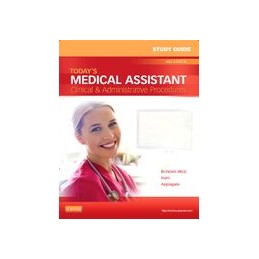- Obniżka


 Dostawa
Dostawa
Wybierz Paczkomat Inpost, Orlen Paczkę, DHL, DPD, Pocztę, email (dla ebooków). Kliknij po więcej
 Płatność
Płatność
Zapłać szybkim przelewem, kartą płatniczą lub za pobraniem. Kliknij po więcej szczegółów
 Zwroty
Zwroty
Jeżeli jesteś konsumentem możesz zwrócić towar w ciągu 14 dni*. Kliknij po więcej szczegółów
Opis
SECTION 1: Introduction to Medical Assisting
1. The Health Care System
2. The Professional Medical Assistant
3. Ethics and Law for the Medical Office
4. Interacting with Patients
SECTION 2: Anatomy and Physiology
5. Introduction to Anatomy and Physiology
6. Integumentary System
7. Skeletal System
8. Muscular System
9. Nervous System
10.The Senses
11. Endocrine System
12. Circulatory System
13. Respiratory System
14. Digestive System
15. Urinary System
16. Reproductive System
SECTION 3: Clinical Component
17. Medical Asepsis and the OSHA Standard
18. Sterilization and Disinfection
19. Vital Signs
20. The Physical Examination
21. Eye and Ear Assessment and Procedures
22. Physical Agents to Promote Tissue Healing
23. The Gynecologic Examination and Prenatal Care
24. The Pediatric Examination
25. Minor Office Surgery
26. Administration of Medication and Intravenous Therapy
27. Cardiopulmonary Procedures
28. Specialty Examinations and Procedures: Colon Procedures, Male Reproductive Health, and Radiology and Diagnostic Imaging
29. Introduction to the Clinical Laboratory
30. Urinalysis
31. Phlebotomy
32. Hematology
33. Blood Chemistry and Immunology
35. Emergency Medical Procedures
SECTION 4: Administrative Component
36. The Medical Record
37. Patient Reception
38. Medical Office Computerization
39. Telephone Techniques
40. Scheduling Appointments
41. Medical Records Management
42. Written Communications
43. Mail
44. Managing Practice Finances
45. Medical Coding
46. Medical Insurance
47. Billing and Collections
48. Office Management and Emergency Preparedness
49. Emergency Protective Practices for the Medical Office
50. Obtaining Employment
